GPC item II response for "Ridge" in d+Au: Global vs Primary track for Charge Identification
According to June 5th, II GPC meeting, we analyze the global and primary tracks. In current paper status, we use the primary track. Now we are going to see how is the global track.
Method:
QA:
1. Momentum, charge, φ angle: primary vs global
2. dcaD (signed dca): global
Dihadron Correlation:
1. TPC-FTPC: primary vs global
2. TPC-TPC: primary vs global
Data set:
Run3
|Vz| < 50 cm
nHitsFit > 25 points for TPC, 5 points for FTPC
nHitsFit/nHitsPoss >= 51%
globa dca < 3 cm
|η|<1 for TPC, 2.8<|η|<3.8 for FTPC
Results:
QA:
1. Momentum, φ, charge angle: primary vs global
a. Pt in TPC vs FTPC-Au
.png) |
.png) |
Figure 1:
Left: TPC. Right: FTPC
X-axis: Global track Pt. Y-axis: Primary track Pt
Conclusion:
Most TPC tracks have the positive relationship between primary and global.
Some positive relationship seen in FTPC tracks below 0.4 GeV/c
b. φ in TPC vs FTPC-Au
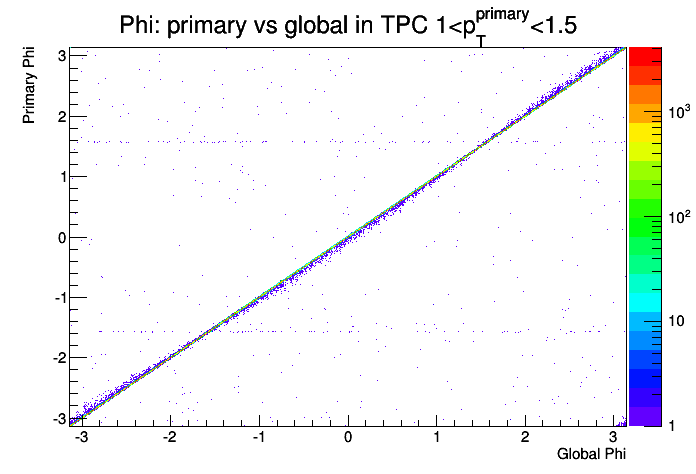 |
 |
.png) |
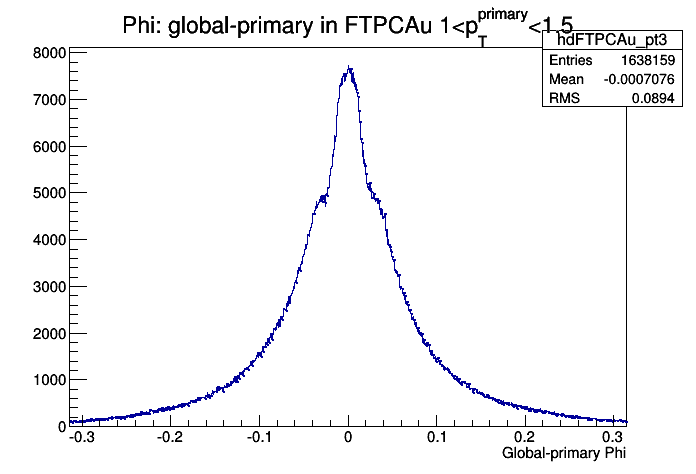 |
Figure 2:
Left: TPC. Right: FTPC
Top: X-axis: Global track φ. Y-axis: Primary track φ
Bottom: X-axis: global φ - primary φ
Conclusion:
Strong positive relationship between global and primary tracks in both TPC and FTPC-Au. FTPC-Au correlation is 30 times wider than TPC correlation.
c. Charge in TPC vs FTPC-Au
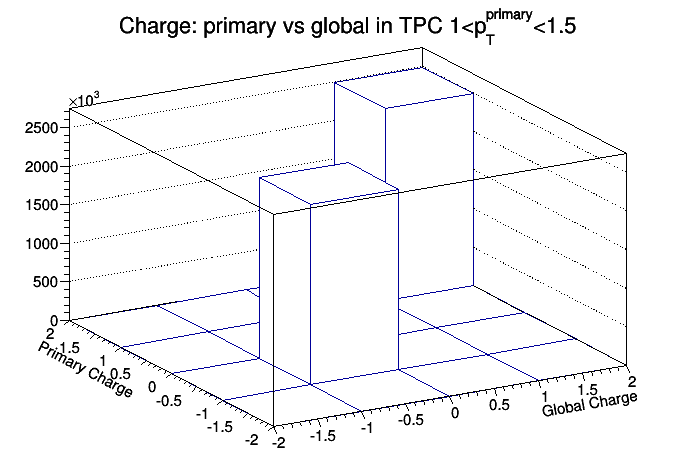 |
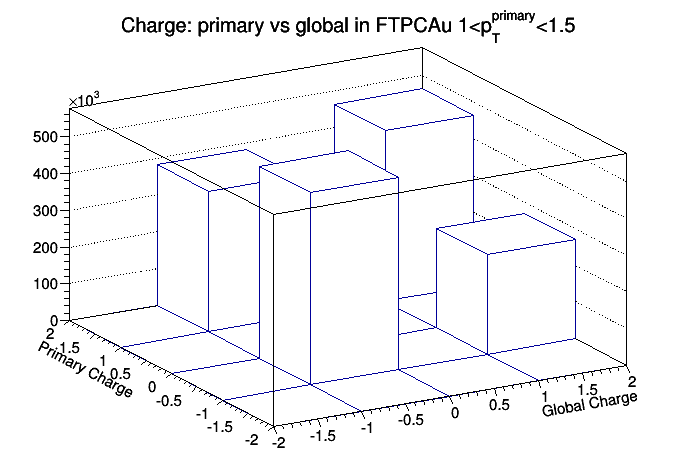 |
Figure 3:
Left: TPC. Right: FTPC
X-axis: Global track charge. Y-axis: Primary track charge
Conclusion:
Few TPC tracks charge change between primary and global.
For FTPC-Au, near half charge change between primary and global.
Summary:
Weak correlation for Px, Pt, but strong correlation for φ between primary and global tracks in FTPC-Au.
Near half tracks have opposite change between primary and global in FTPC-Au
The charge misidentification would effect the TPC-FTPC dihadron correlation.
For more details, see drupal.star.bnl.gov/STAR/blog/yili/dau-ridge-charge-identification-global-vs-primary-tracks-charge-p-ftpc-tpc
2. dcaD (signed dca): global
Signed dca :Signed radial component of global DCA (projected) should be symmetric ideally.
 |
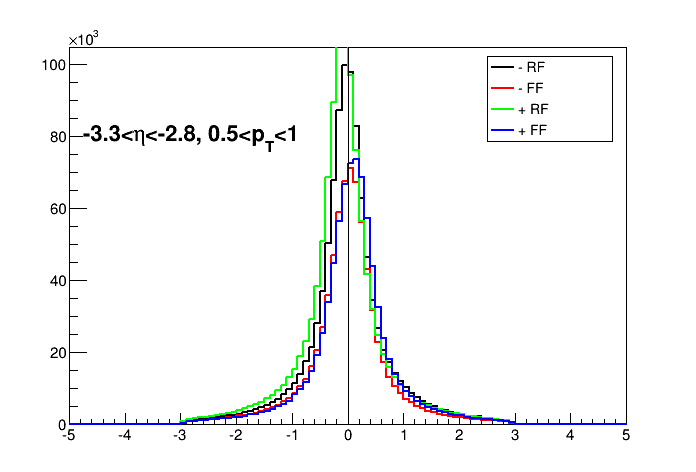 |
Figure 4:
Left: TPC. Right: FTPC
X-axis: Signed Dca
Conclusion:
Signed dca is not symmetric for both TPC and FTPC-Au. It flips between B field so that the effect it would cause will be the same for different B field.
For more details, see drupal.star.bnl.gov/STAR/blog/yili/dau-ridge-charge-identification-signed-dca
Summary:
From the tracking variable comparison and sign dca asymmetry, both TPC-TPC and TPC-FTPC dihadron correlation need to be revisited with global tracks for any change.
Dihadron Correlation:
1. TPC-FTPC: primary vs global
a. Inclusive Charges
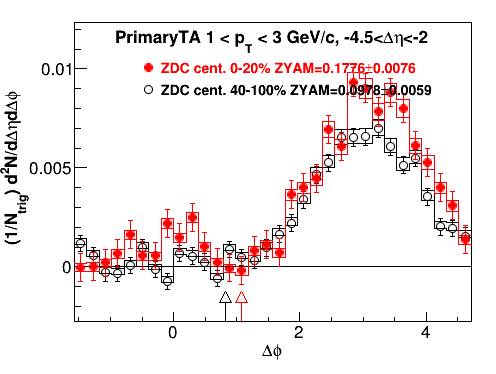 |
.png) |
Figure 5:
TPC-FTPC Dihadron correlation in d+Au@200GeV.
Right: Primary tracks. Left: Global tracks.
Red for central 0-20% collisions. Black for peripheral 40-100%
The trigger and associate particles are the inclusive charge.
b. Positive vs Negative associate particle charge
 |
.png) |
Figure 6:
TPC-FTPC Dihadron correlation in 0-20% d+Au@200GeV.
Right: Global tracks. Left: Primary tracks.
Red points for the positive charge associated particle. Black for negative. The trigger particle is the inclusive charge.
Conclusion:
NO difference seen between different associated particle charges. This is not the same with the result from primary tracks where the near-side ridge is only for the positive associated particle.
For result with primary TPC - global FTPC, see drupal.star.bnl.gov/STAR/blog/yili/dau-ridge-charge-identification-ftpc-global-tracks-instead-primary-tracks
2. TPC-TPC: global
a. Inclusive Charges
 |
.png) |
Figure 7:
TPC-TPC Dihadron correlation in d+Au@200GeV.
Right: Primary tracks. Left: Global tracks.
Red for central 0-20% collisions. Black for peripheral 40-100% Blue for the scaled peripheral (same near-side jet yield).
The trigger and associate particles are the inclusive charge.
b. Unlike- vs Like-sign pairs
 |
.png) |
Figure 8:
TPC-TPC Dihadron correlation with global tracks in 0-20% d+Au@200GeV.
Right: Primary tracks. Left: Global tracks.
Red points for the unlike-sign pairs. Black for like-sign.
Conclusion:
NO difference seen between unlike and like-sign pairs. This is not the same with the result from primary tracks where the near-side ridge is larger in unlike-sign than like-sign.
For more details, see drupal.star.bnl.gov/STAR/blog/yili/dau-ridge-charge-identification-tpc-global-tracks-instead-primary-tracks
Conclusion:
1. Large portion of the FTPC tracks charges are misidentified. (20%)
2. Global track correlations show no dependence on charge for near-side ridge.
- yili's blog
- Login or register to post comments
